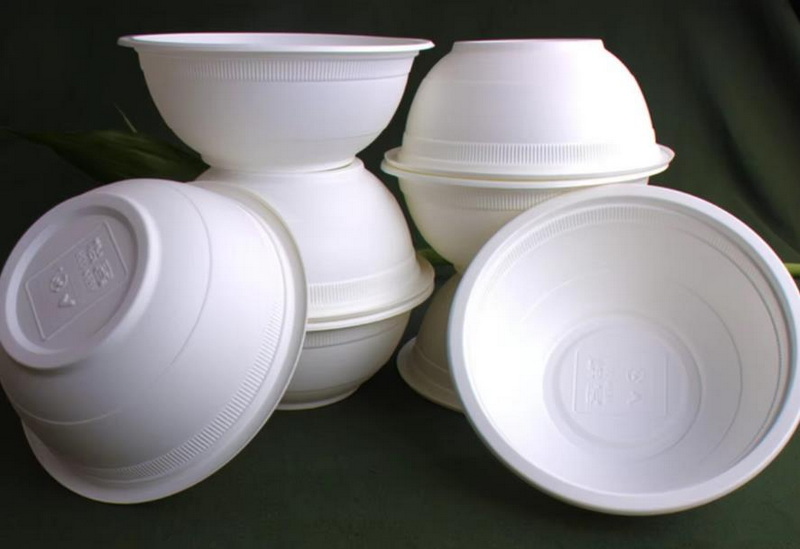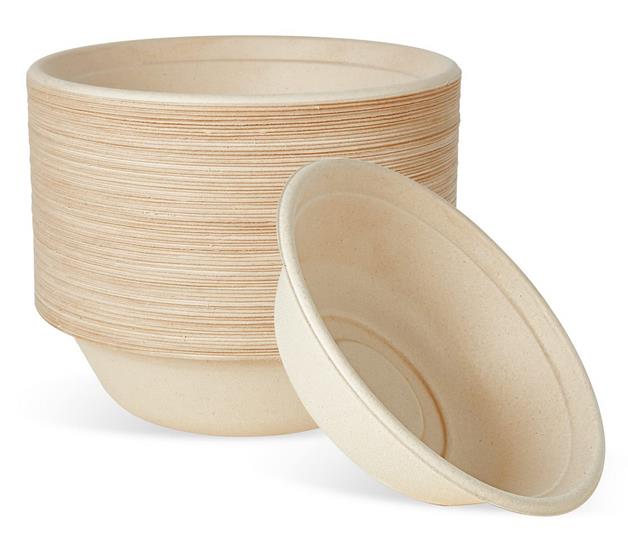
Content Menu
● The Rise of Eco-Friendly Bioplastics
>> What are Bioplastics?
>> The Advantages of Bioplastics
● Materials Used in Eco-Friendly Bioplastic Disposable Soup Bowls
>> Why PLA Coating?
● The Manufacturing Process
● DIY Bioplastic Bowl
● Advantages of Eco-Friendly Bioplastic Disposable Soup Bowls
● Challenges and Future Directions
>> Future Trends
● Conclusion
● FAQ About Eco-Friendly Bioplastic Disposable Soup Bowls
>> 1. Are all bioplastics biodegradable?
>> 2. How long does it take for a PLA-coated paper bowl to biodegrade?
>> 3. Are bioplastic bowls microwave-safe?
>> 4. Can bioplastic bowls handle hot soup?
>> 5. Are there any drawbacks to using bioplastic bowls?
● Citations:
In an era defined by increasing environmental consciousness, the demand for sustainable alternatives to traditional plastic products has surged. Among these alternatives, the ecofriendly bioplastic disposable soup bowl stands out as a promising solution for both consumers and businesses looking to minimize their ecological footprint. This article delves into the intricate processes involved in manufacturing these innovative bowls, highlighting the materials, techniques, and benefits that make them a viable substitute for conventional plastic bowls.

The Rise of Eco-Friendly Bioplastics
Traditional plastics, derived from non-renewable resources like petroleum, pose significant environmental challenges due to their persistence in landfills and contribution to pollution[7]. Bioplastics, on the other hand, are made from renewable biomass sources such as cornstarch, sugarcane, and other plant-based feedstocks[3][7]. These materials offer a more sustainable lifecycle, as they can be composted and safely converted into soil components, often within a few months[7].
What are Bioplastics?
Bioplastics are plastics produced from renewable resources, offering a sustainable alternative to traditional petroleum-based plastics[3]. Not all bioplastics are biodegradable, but many are designed to break down under specific conditions, such as those found in industrial composting facilities[3][5].
The Advantages of Bioplastics
- Reduced Carbon Footprint: Bioplastics utilize renewable resources, decreasing reliance on fossil fuels and lowering greenhouse gas emissions[7].
- Biodegradability and Compostability: Many bioplastics are designed to decompose in industrial composting facilities, reducing landfill waste[1][5].
- Non-Toxic: Bioplastics often do not contain the harmful chemicals found in traditional plastics, making them safer for food contact[5].
Materials Used in Eco-Friendly Bioplastic Disposable Soup Bowls
The selection of materials is a critical factor in producing ecofriendly bioplastic disposable soup bowls. The most common materials include:
- Polylactic Acid (PLA): Derived from plant starch, typically corn, sugarcane, or cassava roots, PLA is a biodegradable thermoplastic material[5]. It is often used as a coating for paper containers to make them waterproof[5].
- Sugarcane (Bagasse): A byproduct of sugarcane processing, bagasse is a fibrous material that can be molded into bowls and other food containers[1][9].
- Bamboo: A fast-growing, sustainable resource, bamboo can be processed into durable and compostable bowls[1].
- Recycled Paper: Using recycled paper reduces the demand for virgin wood pulp, conserving forests and reducing waste[1].
Why PLA Coating?
PLA (Polylactic Acid) is a popular bioplastic used to coat paper bowls because it is made from plant starch and is biodegradable[5]. PLA coating makes paper bowls waterproof and grease-proof, suitable for both hot and cold foods[5].
The Manufacturing Process
The manufacturing process of ecofriendly bioplastic disposable soup bowls involves several key steps, from raw material processing to the final product[10].
1. Raw Material Preparation:
- For PLA-based bowls, the plant starch is extracted and processed into polylactic acid[5].
- For bagasse bowls, the sugarcane fibers are collected and prepared for molding[1][9].
- For paper bowls, the recycled paper is pulped and cleaned[1].
2. Lamination (for Paper Bowls):
- Paper lamination involves applying a thin layer of polymer (PLA, PE, PP, or water-based barrier coating) to improve the paper's qualities[10].
- This coating ensures grease-proofing and water resistance[10].
- The polymer is melted, formed into a thin sheet, and pressed onto the paper[10].
3. Molding and Forming:
- The prepared material is then molded into the desired bowl shape using heat and pressure[10].
- For PLA and bagasse, this often involves injection molding or thermoforming techniques[7].
- Paper bowls are die-cut and then molded into shape[10].
4. Coating (if necessary):
- To enhance water resistance and prevent leakage, the bowls may be coated with a thin layer of PLA or other bioplastic material[5].
- This is particularly common for paper-based bowls[5].
5. Printing and Decoration:
- Custom logos and designs can be printed on the bowls using eco-friendly inks[5].
- High-resolution printing technology ensures that the branding is both visually appealing and sustainable[5].
6. Quality Control:
- Each bowl is inspected to ensure it meets quality standards for durability, leak-proofness, and overall appearance[9].
7. Packaging:
- The finished bowls are carefully packaged for transportation and storage, often using recycled or biodegradable materials[5].

DIY Bioplastic Bowl
It is also possible to create your own bioplastic bowl at home using simple ingredients and materials[2][6].
Materials:
- Water
- Starch
- Vinegar
- Glycerin (available at pharmacies)
- Cooking pot
- Hotplate
- Whisk
- Wooden spoon
- Baking tray
Instructions:
1. Mix 1 tablespoon of starch and 1 teaspoon of vinegar with 4 tablespoons of water in a cooking pot[2]. Add 1 teaspoon of glycerin[2].
2. Stir the mixture thoroughly with a whisk and heat over medium heat, stirring continuously[2].
3. As the mixture thickens, replace the whisk with a wooden spoon[2].
4. After about 10 minutes, you should have a sticky, glassy substance[2]. Spread this substance on a baking tray or another suitable surface[2].
5. Wait at least 24 hours for the bioplastic to dry. Then, peel it off the baking tray[2].
Advantages of Eco-Friendly Bioplastic Disposable Soup Bowls
Environmental Benefits:
- Reduces reliance on fossil fuels[7].
- Decreases landfill waste through biodegradability and compostability[1][5].
- Lowers carbon footprint[7].
Consumer Benefits:
- Safe for food contact[5].
- Microwave-safe options available[1].
- Convenient for single-use applications[9].
Business Benefits:
- Enhances brand image by demonstrating environmental responsibility[5].
- Meets increasing consumer demand for sustainable products[9].
- Can be customized with logos and branding[5].
Challenges and Future Directions
Despite the numerous advantages, the ecofriendly bioplastic disposable soup bowl industry faces several challenges:
- Cost: Bioplastics can be more expensive to produce than traditional plastics, although costs are decreasing as technology improves[7].
- Performance: Some bioplastics may not perform as well as traditional plastics in terms of heat resistance and durability, though advancements are continually being made[9].
- Infrastructure: Adequate composting infrastructure is needed to ensure that biodegradable bioplastics are properly processed[5].
Future Trends
- Technological Advancements: Ongoing research and development are focused on improving the performance and reducing the cost of bioplastics[7].
- Expansion of Feedstock Options: Exploring new and diverse plant-based feedstocks to reduce reliance on single crops like corn[7].
- Policy Support: Government policies and incentives can help drive the adoption of bioplastics by making them more competitive in the market[5].
Conclusion
The ecofriendly bioplastic disposable soup bowl represents a significant step forward in the quest for sustainable alternatives to traditional plastics. By utilizing renewable materials and innovative manufacturing processes, these bowls offer a practical and environmentally responsible solution for single-use food containers. While challenges remain, ongoing advancements and increasing consumer demand promise a bright future for the bioplastics industry. As more businesses and individuals embrace these eco-friendly options, the positive impact on the environment will continue to grow.

FAQ About Eco-Friendly Bioplastic Disposable Soup Bowls
1. Are all bioplastics biodegradable?
No, not all bioplastics are biodegradable[3]. Some bioplastics are designed to be durable and long-lasting, while others are specifically engineered to break down under certain conditions, such as in industrial composting facilities[3][5].
2. How long does it take for a PLA-coated paper bowl to biodegrade?
PLA will break down in 60-90 days under controlled conditions in an industrial facility[5].
3. Are bioplastic bowls microwave-safe?
Some bioplastic bowls are certified safe for microwave usage[1]. This allows users to reheat soup directly in the bowl[1].
4. Can bioplastic bowls handle hot soup?
Yes, PLA-coated paper bowls can handle hot food as well as PE-lined paper bowls[5]. PLA has a lower glass transition temperature compared to PE lining but can still hold hot food when coated on a paper bowl[5].
5. Are there any drawbacks to using bioplastic bowls?
One major drawback is that starch-based bioplastics will start to melt if left in hot water (60°C)[6]. However, they are generally suitable for holding hot soup for a reasonable amount of time[5][6].
Citations:
[1] https://www.yoonpak.com/best-disposable-bowls-for-hot-soup/
[2] https://www.youtube.com/watch?v=8nxuO3SjMQM
[3] https://eupegypt.com/blog/how-are-bioplastics-made/
[4] https://www.bbc.co.uk/learningenglish/chinese/features/lingohack/ep-201001
[5] https://www.yanxiyan.com/pla-lining-paper-bowl/
[6] https://www.daniellewilde.com/wp-content/uploads/2018/10/SDU-Design_FoodForThought_24June2018.pdf
[7] https://www.urthpact.com/bioplastic-manufacturing/
[8] https://www.bbc.co.uk/learningenglish/chinese/features/take-away-english/ep-171120
[9] https://www.craftecopack.com/blog/6-best-disposable-bowls-for-hot-soup-everything-you-need-to-know_b26
[10] https://www.kimecopak.ca/blogs/news/how-are-paper-bowls-made
[11] https://indpro.com/blog/biodegradable-plastic-manufacturing-process/

















